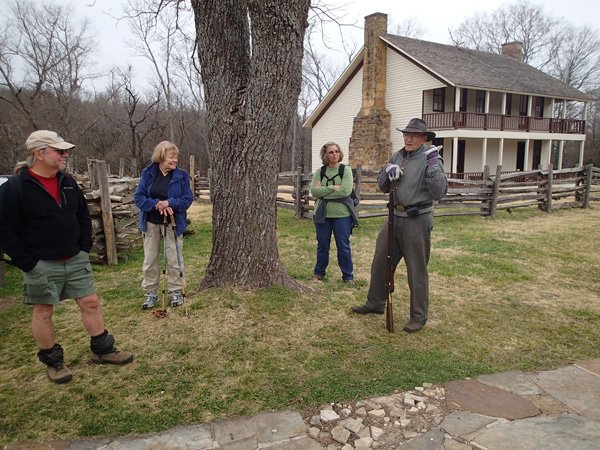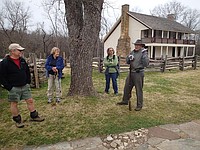PEA RIDGE — Setting out for a hike at Pea Ridge National Military Park seems like a walk through uncharted territory on the rolling landscape where the Battle of Pea Ridge raged in 1862.
Explorers on foot see acres of the Civil War battlefield that visitors miss on the seven-mile driving tour.
Photo Gallery
Pea Ridge hike
The Civil War Battle of Pea Ridge is the focus at Pea Ridge National Military Park. There's a 7-mile driving tour, but visitors who strike out on foot along 10 miles of hiking trails see parts of the 4,300-acre park that aren't seen by car. There's a hidden lake, cemetery, orchard and vast acres of prairie that hikers can explore. Some new sections of trail opened in 2010. Staff photos by Flip Putthoff
Wheels or feet are both fine ways to explore the national park. Hikers are among the few who see a hidden lake at Pea Ridge. They marvel at vast, open grassland that looks more like tallgrass prairie than the forests that surround the park’s 4,300 acres.
Hikers climb to an overlook for long views of the battlefield at a pavilion reached on foot or by car.
Ten miles of hiking trail leads to a cemetery, an orchard and the spot where a field hospital was set up during the battle fought by 26,000 soldiers March 7-8, 1862.
It had been too long since our company of five hikers explored the rarely seen sites at Pea Ridge.
We found more miles of trail through the park than during our last visit. A new trail opened in 2010, so part of our hike was through uncharted territory, indeed.
Most of the hiking at Pea Ridge is along dirt paths or across grass and rock. Some trail follows gravel lanes. Bits and pieces are on the asphalt tour road.
Patrick Poyner and Curtis Tilghman, on staff at Pea Ridge National Military Park, joined our group to show us some of the new trail and revisit the old.
Poyner is well versed in the history of the battle while Tilghman’s specialty is the nature and wildlife in the park.
LANDSCAPE RESTORED
Pea Ridge has a different look than it did 10 years ago. A project to restore the park to its 1862 appearance is nearly finished, Tilghman said.
Tons of cedar trees were taken out in areas that were more open during the Civil War. Tilghman did most of the removal himself.
Trees were planted in some open areas that were once forest.
At a trail intersection, we veered right, but Tilghman said to go left. In short order we found ourselves exploring a cemetery near the site of old Leetown.
Our group walked into western sections of the park we had never seen. Cannon replicas here and there add to the Civil War atmosphere. So do long lengths of split-rail fences.
We decided to play “Stump the Ranger” with Tilghman and quizzed him in a kidding way.
“So Curtis, how many split rails total are in the park, heh heh?”
Undaunted, he whipped out a smartphone and computed the average number of rails per mile times the number of fence miles.
“Ninety-one thousand rails,” he piped. Now we knew.
PRAIRIE WONDER
We decided to skip a side hike to the hidden lake, which is actually a rock quarry dug out for the construction of nearby Arkansas 72.
Instead, we headed east on a gravel lane shown as Ford Road on the park map hikers get free at the Visitor Center. This level route bisects the heart of Pea Ridge National Military Park and visits some glorious sites.
One is unbroken acres of grassland.
“This looks more like a prairie in Kansas than the Ozarks,” mused Mary Chodrick of Fayetteville, one of our hikers.
Acres of grass turned gray by winter shook in the December breeze on this overcast and cool day.
Tilghman showed us an orchard that has been replanted with rows of peach trees. A peach orchard was here among the smoke and flame of battle in 1862.
We passed a pair of tall, wire enclosures that were surely not here during the fight. They look like animal pens, but keep critters out, not in. They’re part of an experiment to see how vegetation responds without deer and other wildlife foraging on it.
Deer - another question we had for our guides. Years ago you’d gaze out from the overlook pavilion and see herds of deer, maybe 50 to 70 in a bunch.
It didn’t take wildlife rocket science to see there were too many deer for the land to support.
We saw a few deer during this visit, but not many. What happened?
Tilghman said that around 2006 there was a major die-off of deer in the park. Nature had taken care of the overpopulation problem.
Hunting was never an option to thin the herd because of a federal law that prohibits hunting in national parks.
SOLDIER ENCOUNTER
A winding descent through cedar-scented forest led us to Elkhorn Tavern, a centerpiece of the battlefield. Here historian Dave Lewis greeted us wearing a Confederate uniform and carrying a musket. We’d been steeped in nature, but Lewis snapped us back to the reality that we were at a battleground where lives were lost.
A rebuilt Elkhorn Tavern stands in place of the original two-story building. It served as a hospital during the Battle of Pea Ridge, Lewis told us. Enough blood was spilled inside that it dripped through the floor planks and into the basement.
We bid farewell to Lewis and wrapped up our hike with a one-mile stroll down the auto tour road and back to the Visitor Center. We’d hiked about seven of the park’s 10 trail miles.
In our minds, parts of the Pea Ridge battlefield were uncharted no more, but familiar ground to be seen again.
Outdoor, Pages 6 on 01/10/2013


